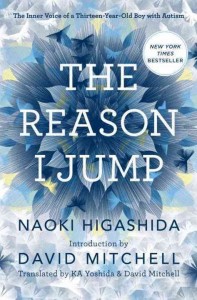
The Reason I Jump: The Inner Voice of a Thirteen-Year-Old Boy with Autism
by Naoki Higashida, translated by KA Yoshida & David Mitchell
135 pages, Random House, August 2013
Buy Now
[Note: All links to this book are Amazon Affiliate links. The link at the end of the article is a National Autism Resources affiliate link. If you click any of these and make a purchase from Amazon or National Autism Resources, we will receive a small commission at no extra cost to you. Thanks for your support!]
![]()
This probably won’t come out right, but here goes: I have always been uncomfortable around autistic kids. Although I don’t often have opportunities to spend time with them, when I do, I don’t know how to be. I have no idea how to talk with an autistic child. Or how to respond if he repeats the same phrase over and over. Or if he begins to rock. Or to wail. The whole notion of teaching autistic children is a big mystery to me.
So I avoid. Not completely – if you saw me in a room with an autistic child, I wouldn’t be hiding in a corner with a blanket over my head. I would be polite, making awkward efforts at conversation. From the outside it might look okay. But inside I’d be anxious, worried that I was doing or saying the wrong thing. And I would be praying that someone else with more knowledge and experience was going to come along very soon.
Now that I have read The Reason I Jump, I feel differently. The book took my discomfort and replaced it with curiosity and affection. It got me thinking about autism in ways I never could before. And most importantly, it made me want to know the autistic kids in my life better.
In the book, Naoki Higoshida, a 13-year-old boy with autism, explains things we wonder about but don’t know how to ask, questions like Why don’t you make eye contact when you’re talking?, Why do you ask the same questions over and over?, and Why do you flap your fingers and hands in front of your face? It’s one thing to have a doctor or researcher explain these things; it’s quite another for the answers to come directly from someone with autism. Naoki writes from lived experience, shedding light on the emotions behind the behaviors: being comforted and calmed by some things, worried and frightened by others. Moments of lightness and joy, of irresistible curiosity, of envy and despair.
As I read, I had to keep reminding myself that the book was written by someone whose autism was so severe he was considered non-communicative — unable to communicate verbally or non-verbally. Naoki learned to write by using a chart containing the letters of the alphabet. With the help of a transcriber, he pointed to the characters one at a time, building the words and paragraphs that eventually formed this book. I imagined another autistic boy I know, Trey, whose communication is very hard to understand, and who is around the same age. Naoki must be like Trey, I thought. The idea that Trey could be writing and thinking all the stuff in this book was nothing short of mind-blowing.
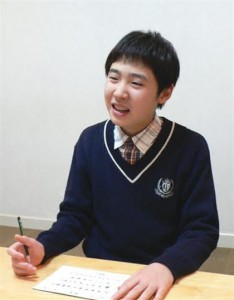
Naoki Higashida with the alphabet chart he used to write the book.
Some of Naoki’s answers fit with my limited understanding of autism. Like this explanation for why he sometimes covers his ears when things get noisy: “Cupping our ears is a measure we take to protect ourselves and get back our grip on where we are.”
But other things he wrote were a big surprise. What struck me most was how sad he feels about the stress he causes others. “The hardest ordeal for us is the idea that we are causing grief for other people. We can put up with our own hardships okay, but the thought that our lives are the source of other people’s unhappiness, that’s plain unbearable.”
This is where the big shift happened for me. Until I read this book, I knew autism caused people to behave in ways that made it hard for them to fit in socially, but I guess I assumed they were unaware of it, that autism simply led them around and they followed, lacking any kind of consciousness about it, any kind of metacognition. That was a big underestimation: The awareness is there, it’s strong, it hurts, and it extends to the people around them. Naoki is painfully aware of how exasperating an autistic kid can be for other people, and he asks us, over and over again, to be patient: “We know we’re making you sad and upset, but it’s as if we don’t have any say in it, I’m afraid, and that’s the way it is. But please, whatever you do, don’t give up on us. We need your help.”
What makes The Reason I Jump so special, so different from other books on the subject is that it was written by a child. David Mitchell, who translated the book with his wife after they received the original Japanese version, describes how it impacted his relationship with his three-year-old autistic son. “Reading it felt as if, for the first time, our own son was talking to us about what was happening inside his head, through Naoki’s words. When you know that your kid wants to speak with you, that he’s taking in his surroundings every bit as attentively as your nonautistic daughter, …then you can be ten times more patient, willing, understanding and communicative.” He contrasts this with other autobiographical books on autism, like Temple Grandin’s Thinking in Pictures: “(These books) tend to be written by adults who have already worked things out, and they couldn’t help me where I needed help most,” namely, to understand the behaviors of his young son.
All teachers, regardless of specialty, should read this book. The most recent figures from the CDC estimate that 1 in 68 children has an autism spectrum disorder. And because schools are required by law to place children in the least restrictive environment for their needs, there’s a good chance that teachers of all subjects will eventually find autistic children in their classes. The Reason I Jump won’t provide you with specific instructional or behavioral strategies, but it will make you want to learn them.
We fear what we don’t know; this was certainly true for me. But now that I’ve heard one voice that was once muted, I know this: Inside every person with autism is someone with thoughts and feelings as complex and interesting as everyone else’s. They want desperately to be understood. And though I still don’t exactly know how to communicate with autistic kids, I now have a much stronger desire to figure it out. ♦
See All Book Reviews
Buy This Book on Amazon
If you found this article useful, I’d love to have you come back for more. Join my mailing list and get weekly tips, tools, and inspiration — in quick, bite-sized packages — all geared toward making your teaching more effective and joyful. To thank you, I’ll send you a free copy of my new e-booklet, 20 Ways to Cut Your Grading Time in Half. I look forward to getting to know you better!

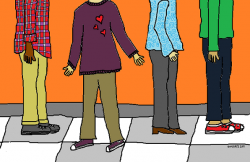
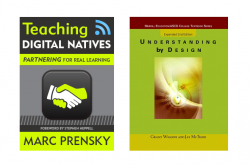
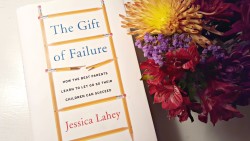

Great review! As a school, Speech/Language Pathologist, I also want to suggest that teachers seek out their school SLP for help, ideas, and strategies for working with students with autism.
Thx for sharing! As a teacher of students with various exceptionalities, I’m always reading & researching to help me understand the uniqueness of all my students. While working with my students with autism, I’ve learned so much from them. They have taught me so much about themselves. I find them to be so interesting! When we are working and things click, we get so excited and spend time sharing the excitement of their success. We definitely have a great time learning and discovering!!! Yes, it’s difficult to know what’s going on inside their heads. It’s important to remember to be patient and take one moment at a time. This book sounds like a great read to help us understand what happens inside the mind of one child with autism. I will definitely to put it in my list of books to read.
This looks like a fantastic read. Any other book recommendations for expecting parents of a child who will likely benefit from Special Education? I’d love to help a pair of friends who recently discovered that their child will need early intervention strategies and help from the beginning. Thanks in advance.
Although I’ve not read this book, it seems to get good reviews: An Early Start for Your Child with Autism: Using Everyday Activities to Help Kids Connect, Communicate, and Learn. You might also want to reach out on Twitter to see if others jump in with good recommendations.
A must read for anyone working with children, let alone those working with children with autism. After listening to your podcast interview with the mum of a child with autism, I read this book. It doesn’t offer answers or strategies, but it does give you so much more… an insight into a world we rarely get the chance to share. For me it also highlighted the fact that autism is a spectrum that many people/children are on – a little patients and empathy goes a long way.
Great insight as to what somebody with autism experiences everyday. Opens your eyes to new ideas and new ways to practice patience and understanding for somebody different than yourself. Need to read this book!